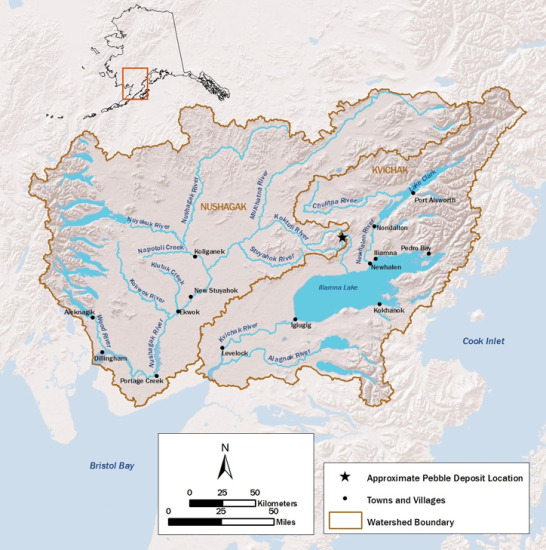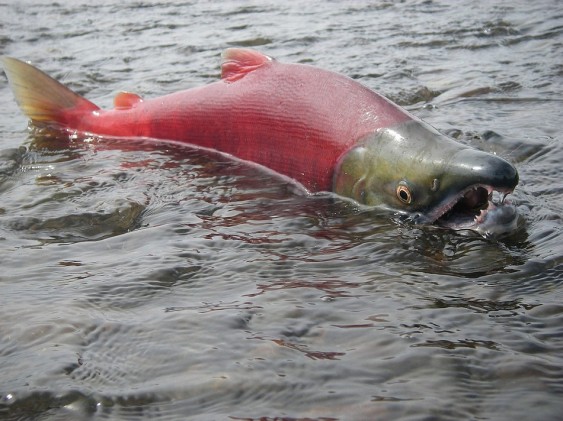[prettyquote]“This is not about Pebble Mine. This is about government overreach.”– Pete Higgins, Alaska State Representative, Fairbanks.
“I believe it to be arrogant to say fishing and mining can coexist.” – Everett Thompson, commercial fisherman and shareholder of the Bristol Bay Native Corporation.[/prettyquote]
Near Alaska’s Bristol Bay— gateway to salmon streams that produce the biggest sockeye runs in the world—a Canadian mining company, Pebble Limited Partnership, wants to build one of the world’s largest open-pit gold, copper, and molybdenum mines. It’s a proposal that is shaping up to be one of the most hotly debated resource questions that the region has seen in years, though few outside the watershed have followed the details. So here’s an overview of the controversy and what it means for the Northwest’s most iconic species.

In the spring of 2010, several Bristol Bay tribes petitioned the US Environmental Protection Agency (EPA) to take action under the federal Clean Water Act to protect the bay’s watershed and salmon habitat from the proposed mine. Since then, the agency has been examining the Pebble Mine and what it means for the watershed.
In January 2014, EPA released a final “Assessment of Potential Mining Impacts on Salmon Ecosystems of Bristol Bay.”“The assessment is a technical resource for governments, tribes, and the public as we consider how to address the challenges of large-scale mining and ecological protection in the Bristol Bay watershed,”reported Denis McLaren, regional administrator for EPA.
In other words, the document is a scientific assessment consistent with the Clean Water Act, but it does not recommend policy or regulatory decisions.That’s not to say it’s not thorough: the assessment went through two drafts, eight public meetings, and independent peer review for technical quality by 12 scientific experts in fields ranging from mine engineering to Alaska Native cultures. It determined that Bristol Bay supports the largest sockeye salmon fishery in the world, producing nearly 50 percent of the world’s sockeye runs, averaging 37.5 million fish each year. And the assessment concluded that large-scale mining in the Bristol Bay watershed poses risks to these salmon, as well as to Alaska Native cultures.
Then, based on the report’s findings, EPA issued a proposal in July to restrict the mine from dropping into water bodies dredged or fill material from mining that would result in any of the following:
- The loss of five or more miles of streams with documented salmon occurrence; or the loss of 19 or more miles of streams without salmon that are tributaries of salmon-bearing streams.
- The loss of 1,100 or more acres of wetlands, lakes, and ponds that connect with salmon streams with or tributaries of those streams.
- Streamflow alterations greater than 20 percent of daily flow in nine or more linear miles of salmon streams.
Since issuing the proposal, EPA has been accepting comments. They have been heated to say the least, ranging from “Hands off Alaska” to “Save Our Salmon.”
US Representative Don Young of Alaska responded to a Maryland congresswoman who supported EPA’s proposal by shouting, “I’ll be damned if I’m going to sit here and watch somebody from Maryland or any other state start telling me or anybody in Alaska how we should be running our state.”

But the Olympian newspaper answered with an editorial declaration that “Saving our planet is everybody’s business,” and commended Washington’s congressional delegation for opposing the Pebble Mine. Pebble Limited Partnership and the state of Alaska have filed suit against EPA.
In addition to the public meetings, EPA will meet with the local tribes for formal consultation. The Bristol Bay region is home to 31 Alaskan Native villages, whose residents depend on salmon as both a major food resource and for their economic livelihood.
The public comment period on EPA’s proposal ended in mid-September, but there are several more chapters yet to be written before we find out whether Bristol Bay’s salmon will share territory with a huge new mine. The agency will review the comments, prepare a response, issue a “recommended determination” by early 2015. After that EPA will coordinate with affected parties before issuing a “final agency determination,” which, as the name suggests, is intended to be EPA’s final action on the Tribal petition to protect the watershed and the world’s largest sockeye run. Yet the Pebble Partnership and the State of Alaska have already made clear that they plan to sue EPA over any decision that restricts mining.
John Abbotts is a former Sightline research consultant. Among his previous articles was an opinion on GM salmon and labeling.


Comments are closed.